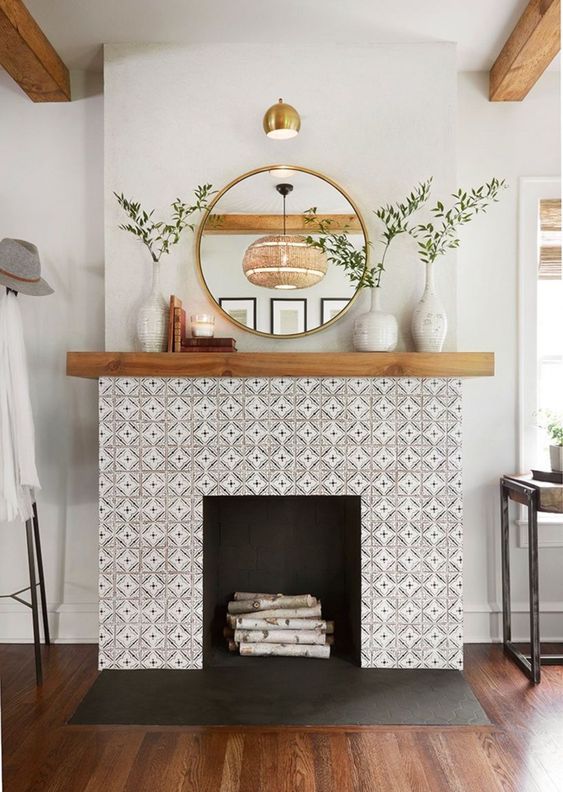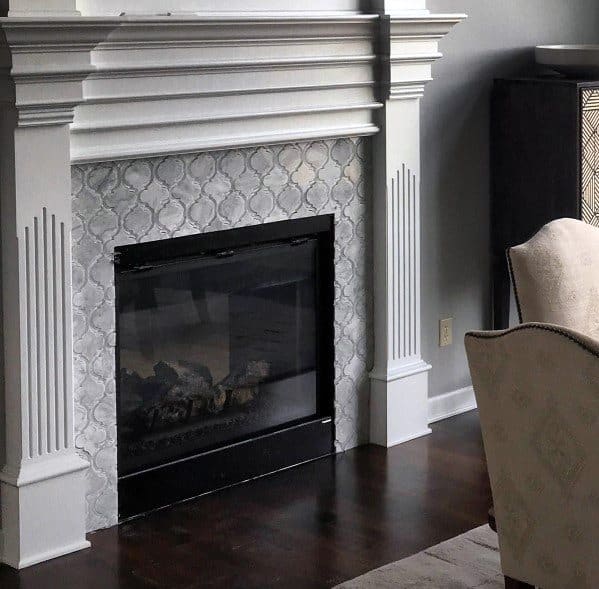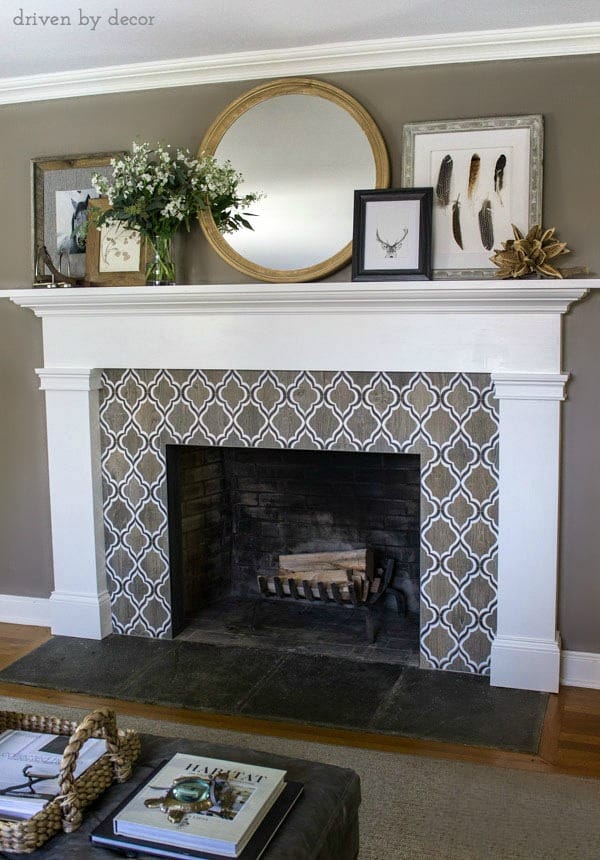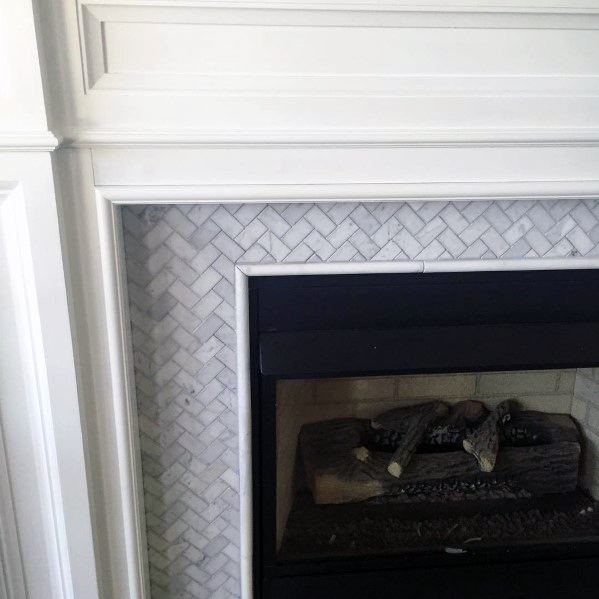Introduction to Patterned Fireplace Tiles
Patterned fireplace tiles are a fantastic way to add personality, color, and a unique design element to your living space. They offer a versatile and creative solution for enhancing the aesthetic appeal of your fireplace, transforming it into a striking focal point in the room. With a wide array of patterns, colors, and materials available, patterned tiles can suit various design styles, from traditional to contemporary.
One of the key benefits of patterned fireplace tiles is their ability to create visual interest. The intricate designs and vibrant colors can draw the eye and add depth to the room. Whether you prefer geometric patterns, floral motifs, or abstract designs, there is a patterned tile to match your taste and complement your home decor. These tiles can be used to cover the entire fireplace surround or as an accent within a larger design scheme.

Another advantage of patterned fireplace tiles is their versatility. They can be used in various parts of the fireplace, including the hearth, surround, and even the interior firebox, depending on the material. This allows for endless design possibilities and the ability to create a cohesive look that ties the fireplace into the rest of the room. Patterned tiles can also be mixed and matched with plain tiles to create a custom design that is uniquely yours.
Patterned fireplace tiles are also durable and easy to maintain. Many tiles are made from materials such as ceramic, porcelain, or natural stone, which are known for their durability and heat resistance. This makes them an ideal choice for use around a fireplace, where high temperatures and occasional exposure to soot and ash are common. Regular cleaning with a damp cloth and mild detergent is usually sufficient to keep the tiles looking their best.

Installation of patterned fireplace tiles can be a manageable DIY project for those with some experience in tiling, but it is also a task that can be handled by professionals. The process involves preparing the surface, applying adhesive, setting the tiles in place, and grouting the joints. The result is a beautifully tiled fireplace that can significantly enhance the overall look and feel of your living space.
Finally, patterned fireplace tiles can add value to your home. A well-designed and visually appealing fireplace can be a selling point for potential buyers, making your home stand out in the market. The investment in quality tiles and a professional installation can pay off in the long run, both in terms of aesthetic enjoyment and potential return on investment.

Historical and Cultural Significance of Patterned Tiles
Patterned tiles have a rich history and cultural significance that dates back centuries. They have been used in various cultures around the world to adorn floors, walls, and, of course, fireplaces. The use of patterned tiles can be traced back to ancient civilizations such as the Greeks, Romans, and Persians, who utilized these decorative elements to enhance their architectural spaces.
In ancient Greece, patterned tiles were often used in public buildings and homes of the wealthy to depict scenes from mythology and daily life. These tiles were typically made from terracotta and featured intricate designs that showcased the artistry and craftsmanship of the time. The use of tiles continued in the Roman Empire, where they were used extensively in baths, villas, and public buildings. Roman tiles often featured geometric patterns and mosaics made from small, colored stones and glass.
The Islamic world also has a long tradition of using patterned tiles in architecture. Islamic tilework is renowned for its intricate geometric patterns and vibrant colors, which are often used to decorate mosques, palaces, and other significant buildings. The Alhambra in Spain and the Blue Mosque in Istanbul are famous examples of Islamic architecture that showcase the beauty and complexity of patterned tiles.

In medieval Europe, patterned tiles were commonly used in churches and cathedrals to create decorative floors and walls. These tiles often featured religious motifs and heraldic symbols, reflecting the cultural and religious significance of the time. During the Victorian era, patterned tiles became popular in domestic architecture, particularly in fireplaces and entryways. The intricate designs and vibrant colors of Victorian tiles added a touch of elegance and sophistication to homes.
In more recent history, the Art Nouveau and Art Deco movements of the late 19th and early 20th centuries saw a resurgence in the use of patterned tiles. These movements embraced bold colors, abstract designs, and floral motifs, which were reflected in the tiles of the period. Patterned tiles from this era often feature intricate, flowing designs that capture the essence of the artistic movements.
Today, the use of patterned tiles continues to be a popular choice for homeowners and designers seeking to add a touch of history and cultural significance to their spaces. Whether inspired by ancient civilizations, Islamic artistry, medieval Europe, or more recent artistic movements, patterned fireplace tiles offer a timeless and versatile design element that can enhance the beauty and character of any home.

Interesting Articles You May Want to Check:
- Tile on Drywall Fireplace
- Craftsman Fireplace Tile Designs
- Fireplace Threshold Tile
- Heat Proof Paint for Fireplace Tiles
- Glass Tile Fireplace Surround Design

Choosing the Right Patterned Tiles for Your Fireplace
Selecting the perfect patterned tiles for your fireplace involves considering several factors, including the design style, color scheme, material, and practical considerations such as durability and maintenance. The first step is to determine the overall design style you want to achieve. Patterned tiles come in a wide range of styles, from traditional to modern, so it’s important to choose a design that complements the existing decor of your room.
For a traditional look, consider tiles with intricate floral patterns, classic motifs, or historical designs. These tiles can add a touch of elegance and timeless beauty to your fireplace. If you prefer a more contemporary style, geometric patterns, abstract designs, and bold colors can create a striking and modern focal point. It’s also possible to mix and match styles to create a unique and eclectic look that reflects your taste.
Color is another crucial factor when choosing patterned fireplace tiles. The color scheme should complement the overall palette of your room. Neutral colors such as white, gray, and beige can create a subtle and sophisticated look, while bold colors like blue, green, or red can make a dramatic statement. Consider the existing colors in your room and choose tiles that either blend seamlessly or provide a striking contrast.

The material of the tiles is also an important consideration. Ceramic and porcelain tiles are popular choices for fireplaces due to their durability and heat resistance. These materials are available in a wide range of patterns and colors, making it easy to find a design that suits your style. Natural stone tiles, such as marble, granite, and limestone, offer a luxurious and timeless look but may require more maintenance to keep them looking their best.
Practical considerations such as durability and maintenance are also important when choosing patterned tiles for your fireplace. The tiles should be able to withstand the heat and occasional soot and ash from the fireplace. Ceramic and porcelain tiles are generally low-maintenance and easy to clean, while natural stone tiles may require regular sealing and special cleaning products to maintain their appearance.
Finally, it’s essential to consider the layout and installation of the tiles. Patterned tiles can be used to cover the entire fireplace surround or as an accent within a larger design. The layout of the tiles should be planned carefully to ensure that the patterns align correctly and create a cohesive look. Professional installation may be necessary to achieve the best results, especially for complex patterns or large areas.

Installation Process for Patterned Fireplace Tiles
Installing patterned fireplace tiles can be a rewarding project that transforms your fireplace into a stunning focal point. The process involves several key steps, including surface preparation, tile layout, application of adhesive, setting the tiles, and grouting. Whether you’re a DIY enthusiast or prefer to hire a professional, understanding the installation process can help ensure a successful outcome.
The first step in the installation process is surface preparation. The fireplace surround should be clean, dry, and free of any debris or old adhesive. If the surface is uneven, it may need to be leveled with a suitable patching compound. For existing fireplaces, removing any old tiles or finishes is necessary to create a smooth and stable surface for the new tiles.
Once the surface is prepared, the next step is to plan the layout of the tiles. This involves arranging the tiles in the desired pattern and marking the placement on the wall. It’s important to take accurate measurements and use a level to ensure that the tiles are aligned correctly. Dry fitting the tiles before applying adhesive can help visualize the final layout and make any necessary adjustments.
The application of adhesive is the next step in the installation process. A high-quality tile adhesive should be used to ensure that the tiles adhere securely to the surface. The adhesive should be applied evenly using a notched trowel, and the tiles should be pressed firmly into place. It’s important to follow the manufacturer’s instructions for the specific adhesive being used, including any recommended curing times.
Setting the tiles involves carefully placing them in the desired pattern and ensuring that they are level and aligned. Spacers can be used to maintain even gaps between the tiles, which will be filled with grout later. It’s important to work methodically and check the alignment frequently to avoid any issues with misaligned tiles. Any adjustments should be made before the adhesive fully sets.
Once the tiles are set and the adhesive has cured, the final step is to apply grout. Grout is used to fill the gaps between the tiles and create a finished look. The grout should be applied using a rubber float, working it into the joints and removing any excess with a damp sponge. It’s important to choose a grout color that complements the tiles and enhances the overall design. After the grout has cured, any remaining haze can be wiped away with a clean cloth.
The installation of patterned fireplace tiles can be a detailed and time-consuming process, but the end result is a beautifully tiled fireplace that adds character and style to your home. Whether you choose to tackle the project yourself or hire a professional, careful planning and attention to detail are key to achieving a successful and visually stunning outcome.

Maintenance and Care for Patterned Fireplace Tiles
Maintaining and caring for patterned fireplace tiles is essential to keep them looking their best and ensure their longevity. Different materials require different maintenance routines, so it’s important to understand the specific needs of your tiles. Regular cleaning, periodic sealing, and addressing any damage promptly can help preserve the beauty and functionality of your fireplace tiles.
Regular cleaning is the first step in maintaining patterned fireplace tiles. For ceramic and porcelain tiles, a simple wipe-down with a damp cloth and mild detergent is usually sufficient to remove dust, soot, and dirt. It’s important to avoid using harsh chemicals or abrasive cleaners that could damage the tiles or the grout. Natural stone tiles may require special cleaning products designed for stone surfaces to prevent staining and preserve their appearance.
Periodic sealing is necessary for some types of tiles, particularly natural stone. Sealing helps protect the tiles from stains, moisture, and other damage. The frequency of sealing depends on the type of stone and the level of use. It’s important to follow the manufacturer’s recommendations for sealing and use a high-quality sealant designed for the specific type of stone. Regularly checking the tiles for signs of wear and reapplying sealant as needed can help maintain their appearance and durability.
Addressing any damage promptly is crucial to prevent further issues. Cracks, chips, or loose tiles should be repaired as soon as possible to avoid additional damage and maintain the integrity of the tiled surface. Small cracks and chips can often be repaired with a suitable filler or adhesive, while larger issues may require professional repair. It’s important to use materials that match the original tiles and follow the manufacturer’s instructions for any repair products.
Grout maintenance is also an important aspect of caring for patterned fireplace tiles. Grout can become discolored or damaged over time, particularly in areas exposed to heat and soot. Regular cleaning with a grout cleaner and a soft brush can help keep the grout looking clean and fresh. In some cases, regrouting may be necessary to restore the appearance and functionality of the tiled surface. Choosing a high-quality grout and applying a grout sealer can help protect the grout and extend its lifespan.
Preventive measures can also help maintain the beauty and functionality of patterned fireplace tiles. Using a fireplace screen or glass doors can help reduce the amount of soot and ash that comes into contact with the tiles. Placing a protective mat or rug in front of the fireplace can help prevent scratches and damage from logs or tools. Regularly inspecting the tiles and addressing any issues promptly can help ensure that your fireplace remains a beautiful and functional focal point in your home.
Proper maintenance and care for patterned fireplace tiles not only enhances their appearance but also extends their lifespan. By following a regular cleaning routine, addressing any damage promptly, and taking preventive measures, you can keep your fireplace tiles looking beautiful and ensure that they continue to add value and charm to your home.

Design Ideas and Inspiration for Patterned Fireplace Tiles
Patterned fireplace tiles offer endless design possibilities and can be used to create a variety of looks, from classic and traditional to modern and eclectic. Here are some design ideas and inspiration to help you create a stunning fireplace that reflects your style and enhances your living space.
For a classic and timeless look, consider using patterned tiles with traditional motifs such as floral designs, damask patterns, or intricate scrollwork. These tiles can add a touch of elegance and sophistication to your fireplace, creating a focal point that exudes charm and character. Pairing these tiles with a classic mantel and traditional furnishings can create a cohesive and inviting space.
If you prefer a more contemporary style, geometric patterns and abstract designs can create a bold and modern look. Hexagons, chevrons, and herringbone patterns are popular choices that can add visual interest and a sense of movement to your fireplace. Bold colors and contrasting hues can enhance the modern aesthetic, making your fireplace a striking and dynamic focal point.
For a rustic or farmhouse look, consider using patterned tiles with earthy tones and natural textures. Tiles with wood grain patterns, stone textures, or distressed finishes can create a warm and cozy atmosphere. Pairing these tiles with natural wood beams, rustic furnishings, and neutral color palettes can create a charming and inviting space that feels like a cozy retreat.
An eclectic style can be achieved by mixing and matching different patterned tiles to create a unique and personalized look. Combining tiles with different colors, patterns, and textures can create a vibrant and dynamic design that reflects your individuality. This approach allows for creative expression and the ability to incorporate various design elements and influences into your fireplace.
Moroccan and Mediterranean-inspired designs are another popular choice for patterned fireplace tiles. These styles often feature bold colors, intricate patterns, and a mix of geometric and floral motifs. Using these tiles can create a rich and exotic look that adds a touch of global flair to your home. Pairing these tiles with decorative elements such as lanterns, woven textiles, and vibrant accessories can enhance the overall aesthetic.
Finally, for a minimalist and clean look, consider using patterned tiles with subtle designs and neutral colors. Simple patterns such as stripes, dots, or grids can add a touch of elegance without overwhelming the space. Neutral colors such as white, gray, or beige can create a serene and calming atmosphere. Pairing these tiles with sleek furnishings and minimalist decor can create a sophisticated and modern look.
Patterned fireplace tiles offer endless design possibilities and can be used to create a variety of looks, from classic and traditional to modern and eclectic. Whether you prefer bold and vibrant designs or subtle and understated patterns, there are patterned tiles to suit your style and enhance your living space. The key is to choose tiles that reflect your taste and create a cohesive look that complements the overall design of your home.

Common Mistakes to Avoid
Patterned fireplace tiles can transform your fireplace into a stunning focal point, but there are several common mistakes to avoid to ensure a successful installation and long-lasting beauty. One of the most frequent mistakes is incorrect measurements. Taking inaccurate measurements can lead to tiles that do not fit properly, causing gaps or misalignment. It is crucial to measure the fireplace and wall area accurately and double-check the measurements before purchasing or cutting tiles.
Another common mistake is choosing the wrong materials. While aesthetics are important, it is equally important to select tiles that are suitable for the specific conditions of a fireplace. For instance, some tiles may not be heat-resistant or durable enough to withstand the temperatures and wear associated with a fireplace. It is essential to choose tiles that are both aesthetically pleasing and functionally appropriate for a fireplace surround.
Improper installation techniques can also lead to issues with patterned fireplace tiles. For example, failing to secure the tiles properly to the wall can result in a wobbly or unstable surround. It is important to use the correct type of adhesive, spacers, and grouting techniques for the tiles and wall type. Additionally, ensuring that the tiles are level and aligned during installation is crucial for a professional and finished look.
Ignoring the existing structural and design elements of the room is another mistake to avoid. The patterned tiles should complement the overall design and architecture of the room. Choosing tiles that clash with the room’s style or scale can create a disjointed and unbalanced look. It is important to consider the room’s decor, color scheme, and architectural features when selecting and designing a patterned fireplace tile layout.
Overcomplicating the design is another common pitfall. While it can be tempting to incorporate numerous patterns and colors, a busy or overly complex tile design can overwhelm the space and detract from the overall aesthetic. It is often best to keep the design simple and cohesive, focusing on a few key elements that enhance the beauty and functionality of the fireplace.
Lastly, neglecting maintenance and care of the patterned fireplace tiles can lead to long-term issues. Different materials require different types of maintenance to keep them looking their best. For example, ceramic and porcelain tiles may need regular cleaning, while natural stone tiles may require periodic sealing. Understanding the maintenance requirements of the chosen tiles and adhering to them can help ensure the longevity and beauty of the fireplace surround.

What materials are best for patterned fireplace tiles?
The best materials for patterned fireplace tiles depend on your aesthetic preferences and functional requirements. Popular choices include ceramic and porcelain tiles for their durability and heat resistance. Natural stone tiles, such as marble, granite, and limestone, offer a luxurious and timeless look but may require more maintenance. Glass tiles can create a striking and modern design but should be used with caution in high-heat areas. Each material has its pros and cons, so it’s important to choose one that suits your specific needs and style.
Can I install patterned fireplace tiles myself, or do I need a professional?
While many homeowners can install patterned fireplace tiles as a DIY project, it depends on your skill level and the complexity of the design. Basic installations involving ceramic or porcelain tiles can often be done with standard tools and some patience. However, more complex installations involving intricate patterns, natural stone, or large areas may require professional expertise to ensure safety and a polished finish. If in doubt, consulting with a professional can provide peace of mind and ensure a successful installation.
How do I maintain and clean patterned fireplace tiles?
Maintenance and cleaning requirements vary depending on the material of the tiles. Ceramic and porcelain tiles can be cleaned with a damp cloth and mild detergent. Natural stone tiles may require special cleaning products designed for stone surfaces and periodic sealing to prevent staining. Glass tiles can be wiped down with a glass cleaner. Regularly cleaning the grout with a suitable grout cleaner and addressing any damage promptly can help maintain the appearance and functionality of the tiles. Always follow the manufacturer’s recommendations for the specific material.
Are patterned fireplace tiles safe?
Patterned fireplace tiles can be safe if they are properly installed and made from appropriate materials. Many tiles are designed with heat-resistant properties to enhance safety. Proper installation ensures that the tiles are securely attached and do not pose a risk of falling or shifting. Additionally, the design of the tiles can help prevent accidental contact with hot surfaces, which is particularly important in homes with children or pets. It’s crucial to follow all safety guidelines and manufacturer instructions during installation and use.
Can patterned fireplace tiles be customized?
Yes, patterned fireplace tiles can often be highly customized to fit your specific design preferences and the dimensions of your fireplace. Customization options include the choice of materials, colors, patterns, and finishes. Custom tiles can be tailored to match the existing decor of your room or create a unique design that stands out. Many manufacturers and tile designers offer bespoke services to create one-of-a-kind tiles that reflect your style and enhance the overall look of your fireplace.
What are some popular design trends for patterned fireplace tiles?
Popular design trends for patterned fireplace tiles include geometric patterns, which offer a modern and dynamic look; vintage and retro designs, which add a touch of nostalgia and charm; and natural textures, such as wood grain and stone, which create a warm and rustic atmosphere. Other trends include Moroccan and Mediterranean-inspired patterns, which bring a vibrant and exotic flair, and minimalist designs with subtle patterns and neutral colors, which create a sleek and sophisticated aesthetic. These trends can be adapted to suit various design styles and preferences.

Related Posts: